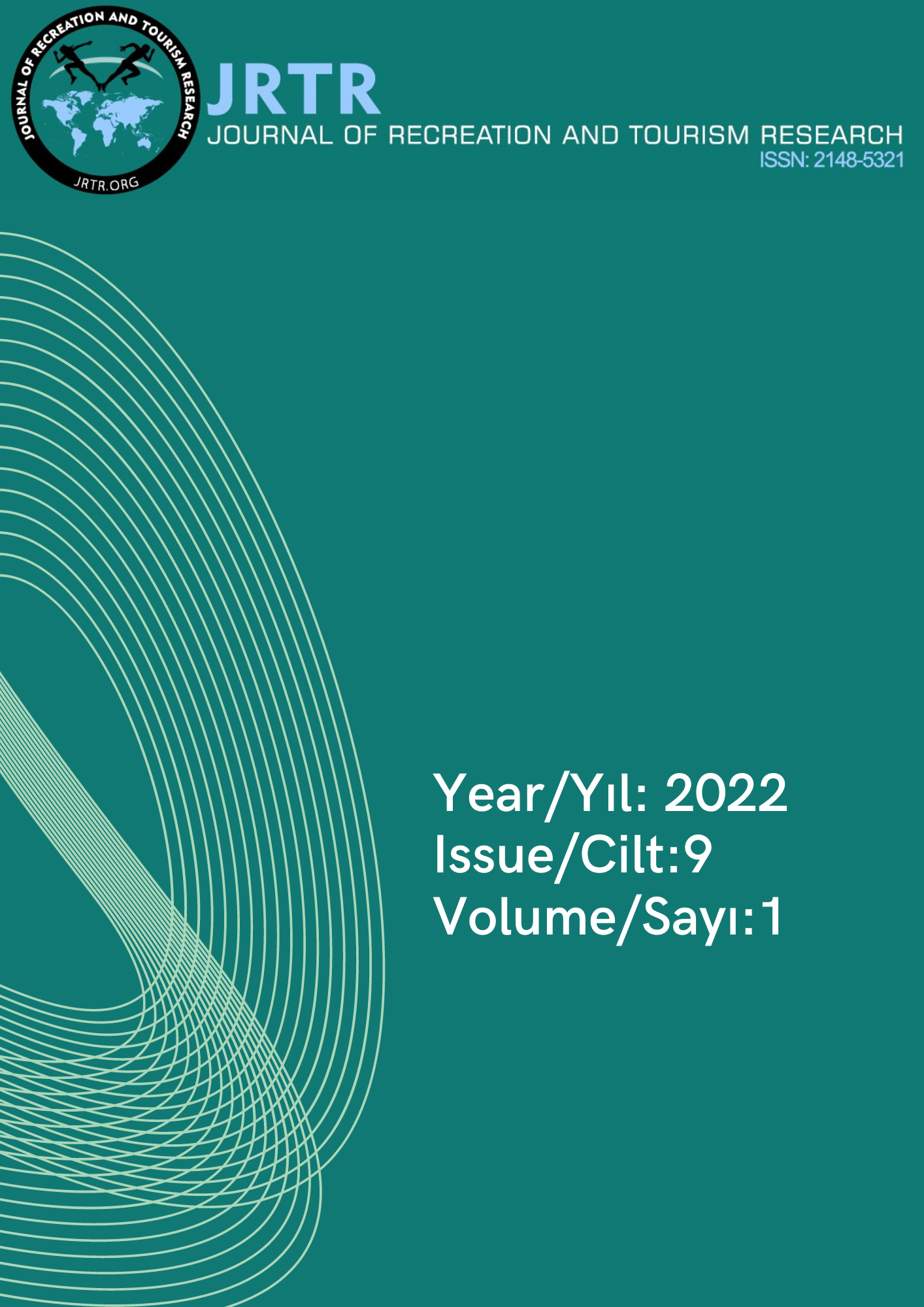TURİST REHBERLERİNİN SANAT TEMALI TURLARDA YARATTIĞI DEĞER ALGISI
DOI:
https://doi.org/10.5281/zenodo.6399167Anahtar Kelimeler:
Turist Rehberliği Eğitimi, Sanat Turizmi, Sanat Turları, Değer YaratmaÖzet
Bu araştırmada turist rehberlerinin sanat temalı turlarda müşteri değeri yaratma etkisi tespit edilmek amaçlanmıştır. Nitel araştırma yöntemleri ile yürütülmüş olan araştırmada, turistler ve rehberlerle görüşmeler gerçekleştirilmiştir. Verilerin elde edilmesi sürecinde, sanat turu yönetmiş olan turist rehberleri ve bu turlara katılan turistlerin görüşlerine ulaşmak esas alınmıştır. Kartopu örneklem yöntemiyle ulaşılan örneklem ile 20.02.2022-01-03.2022 tarih aralığında telefon aracılığıyla görüşülmüştür. Araştırma bulguları ile, rehberlerin ve turistlerin sanat turlarına dair algıladıkları değer tespit edilmiştir. Rehberlerin, turistler nezdinde algılanan değere katkısı olumlu yönde tespit edilmiş olmakla birlikte, sanat turları içeriğine dair bilgi aktarımlarının yetersiz bulunduğu turist katılımcılar tarafından ifade edilmiştir. Bulgular doğrultusunda, sanat turları ve bienal turları adıyla turist rehberliğinde bir uzmanlık alanı olması önerilmiştir. İyi bir sanat turunun nasıl programlanması ve yönetilmesi gerektiği konularında da öneriler geliştirilmiştir.
İndirmeler
Referanslar
Andron S. (2018). Selling streetness as experience: The role of street art tours in branding the creative city. The Sociological Review, 66(5), 1036-1057.
Rokenes, A., Schumann, S. & Rose, J. (2015). The art of guiding in nature-based adventure tourism – how guides can create client value and positive experiences on mountain bike and backcountry ski tours. Scandinavian Journal of Hospitality and Tourism, 15(1), 62-82.
Arnould, E. J. & Price, L. L. (1993). River magic: Extraordinary experiences and the extended service encounter. Journal of Consumer Research, 20(1), 24–45.
Bagul, A. P. (2012). Art tourism in Malaysia: Research issues. Travel & Tourism Research Association Asia-Pacific Chapter, 1-4.
Beedie, P. (2003). Mountain guiding and adventure tourism: Reflections on the choreography of the experience. Leisure Studies, 22, 147–167.
Bitner, M. J. (1992). Servicescapes: The impact of physical surroundings on customers and employees. Journal of Marketing, 56(2), 57-71.
Buckley, R. (2010). Adventure tourism management. Amsterdam: Butterworth-Heinemann.
Campos, A. C., Mendes, J., Valle, P. O. D. & Scott, N. (2018). Co-creation of tourist experiences: A literature review. Current Issues in Tourism, 21(4), 369-400.
Cohen, E. (1985). The tourist guide: The origin, structure and dynamics of a role. Annals of Tourism, 12, 5– 29.
Cohen, E. & Avieli, E. (2004). Food in tourism: Attraction and impediment. Annals of Tourism Research, 31, 755–778.
Curtin, S. (2009). Managing the wildlife tourism experience: The importance of tour leaders. International Journal of Tourism Research, 12, 219–236.
Eco, U. (1977). Das offene kunstwerk, Gabler, Wiesbaden.
Fabricius, M. P. (2001). Competitive strategies for tourism destinations, Doctoral dissertation, University of South Africa.
Franklin, A. (2018). Art tourism: a new field for tourist studies. Tourist Studies, 18(4), 399-416.
Gronroos, C. (2012). Conceptualising value co-creation: A journey to the 1970s and back to the future. Journal of Marketing Management, 28 (13/14), 1520-1534.
Holbrook, M. B. (2006). Consumption experience, customer value, and subjective personal introspection: An illustrative photographic essay. Journal of Business Research, 59(6), 714-725.
Jensen, Ø. (2010). Social mediation in remote developing world tourism locations – the significance of social ties between local guides and host communities in sustainable development. Journal of Sustainable Tourism, 18(5), 615–633.
Lin, Z., Chen, Y. & Filieri, R. (2017). Resident-tourist value co-creation: the role of residents’ perceived tourism impacts and life satisfaction. Tourism Management, 61, 436-442.
Mathisen, L. (2012). The exploration of the memorable tourist experience. Advances in Hospitality and Leisure, 8, 21–41.
Özgürel, G. & Baysal, K. (2018). Sanat turizmi açısından müze evler: Zeki Müren sanat müzesi örneği. Journal of Social and Humanities Sciences Research, 5(31), 4727-4741.
Pedersen, A. J. (2012). Opplevelsesøkonomi – kunsten a˚ designe opplevelser [Experience economy – the art of designing experiences]. Oslo: Cappelen Damm AS.
Pereira, E. (2005). How do tourist guides add value to an ecotour? Interpreting interpretation in the state of Amazonas, Brazil. Hospitality Review, 23(2), 1-8. Retrieved from http://digitalcommons.fiu.edu/ hospitalityreview/vol23/iss2/1.
Pine, J. & Gilmore, J. (1999). The experience economy: Work is theatre & every business a stage. Boston: Harvard Business Press.
Pomfret, G. (2011). Package mountaineer tourists holidaying in the French Alps: An evaluation of key influences encouraging their participation. Tourism Management, 32, 501–510. doi:10.1016/j.tourman. 2010.04.001
Pongsakornrungsilp, S. & Schroeder, J. E. (2011). Understanding value co-creation in a co-consuming brand community. Marketing Theory, 11(3), 303-324.
Porter, M. (1985). The value chain and competitive advantage, (Ed.) Barnes D., In Understanding Businesses: Processes, 33-61, New York: Routledge.
Prahalad, C. K. & Ramaswamy, V. (2004). Co-creation experiences: The next practice in value creation. Journal of Interactive Marketing, 18(3), 5-14.
Prebensen, N. K. & Foss, L. (2011). Coping and co-creation in tourist experience. International Journal of Tourism Research, 13(1), 54–67.
Prebensen, N. K., Chen, J. S. & Uysal, M. (2014). Creating experience value in tourism. Boston: CABI.
Sandström, S., Edvardsson, B., Kristensson, P. & Magnusson, P. (2008). Value in use through service experience. Managing Service Quality: An International Journal, 18(2), 112-126.
Sheth, J. N., Newman, B. I. ve Gross, B. L. (1991). Consumption Values and Market Choices: Theory and Applications. Cincinnati, OH: South-Western Publishing.
Sheth, J. N. & Uslay, C. (2007). Implications of the revised definition of marketing: from exchange to value creation. Journal of Public Policy and Marketing, 26(2), 302-307.
Stone, D. L. (1997). A comparative study of two art museum tours and their impact on adult learning. Visual Arts Research, 23(1), 142–150.
Tajzadeh-Namin, A. (2012). A review on value creation in tourism industry. Management Science Letters, 2(1), 203-212.
Tekin Özbek, Ö, & Öz Çelikbaş, E. (2021). Somut olmayan kültürel miras temalı turistik aktivitelerin terapötik etkisi: Bursa Karagöz müzesi örneği. Türk Turizm Araştırmaları Dergisi, 5(4), 2723–2736.
Uğuz, S. Ç. (2015). Sanat turizmi kapsamında sanat köyleri/ sanat akademileri/ sanat kampları uygulamaları ve kırsal turizme katkıları. Uluslararası Sosyal ve Ekonomik Bilimler Dergisi. 5 (2), 25-28.
Vargo, S. L. & Lusch, R. F. (2004). Evolving to a new dominant logic for marketing. Journal of Marketing, 68(1), 1-17.
Yıldırım, A. & Şimşek, H. (2005). Sosyal bilimlerde nitel araştırma yöntemleri. Ankara: Seçkin Yayıncılık.
İndir
Yayınlanmış
Nasıl Atıf Yapılır
Sayı
Bölüm
Lisans
Telif Hakkı (c) 2022 Journal of Recreation and Tourism Research

Bu çalışma Creative Commons Attribution-NonCommercial 4.0 International License ile lisanslanmıştır.






